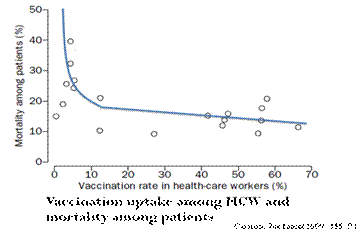Competency #5: Population Health
This competency applies relevant principles of population health for improving immunization coverage rates.
Learning Objectives
The health professional will be able to perform the following:
- Use specific examples to show how immunization is a population-based health strategy.
- Explain the concept of herd immunity (also called community immunity) in non-scientific terms.
- Explain, using examples, why vaccine-preventable diseases return when immunization coverage rates decrease.
- Explain how immunization registries can benefit not only individuals but also populations.
- Present the case for the importance of having a highly immunized healthcare workforce.
- Use health promotion planning model to identify barriers (economic, educational, system-based, and social factors) to immunization uptake.
- Use health promotion strategies to improve immunization coverage rates.
Introduction
Vaccines not only prevent disease in an individual but also prevent disease in the population. The epidemiology triangle is used to understand herd immunity and the importance of immunization rates in population health.
(Source- BCCDC Immunization Competency Program)
What is a Population Health Approach?
Population health is an approach to health that aims to improve the health of the entire population and to reduce health inequities among population groups. In order to reach these objectives, it looks at and acts upon the broad range of factors and conditions that have a strong influence on our health. Action is directed at the health of an entire population, or sub-population, rather than individuals. This is done through evidence based decision making to identify priorities and strategies to improve health.
(Source: PHAC- http://www.phac-aspc.gc.ca/ph-sp/approach-approche/appr-eng.php#health)
Herd Immunity
Herd immunity (or community immunity) describes a type of immunity that occurs when the vaccination of a portion of the population (or herd) provides protection to unvaccinated individuals. (John TJ, Samuel R, 2000). This is accomplished because, by having a large percentage of the population vaccinated, it reduces the spread of the pathogen within the community. Unvaccinated individuals can be individuals in older age groups like in the pneumococcal example. It can also be in groups that can’t be vaccinated, ex. newborns or those with chronic illnesses or individuals allergic to vaccines.
The Return of Disease When Immunization Rates Go down
As immunization rates increase, the vaccine preventable disease (VPD) diminishes to the point that the general population becomes more concerned about the potential of adverse events from the immunization. This generates a loss of confidence and a decrease in immunization rates. Subsequently, if an outbreak occurs, a re-uptake of immunization occurs and confidence returns. In some cases the vaccine preventable disease is eradicated and the immunization program can be stopped for that infection (e.g. smallpox).
Diagram: Lifecycle of a Vaccine Program

Source: Robert Chen, CDC Atlanta
Health Care Worker Immunization
The importance of immunization of health care workers (HCWs) should be emphasized as immunization provides an opportunity to protect the HCW and prevents the transmission of vaccine preventable illnesses to their families or to the patients under their care. During an outbreak, non-immunized HCWs may not be able to work at a time when they could be most needed. A well-immunized healthcare workforce is an essential component in reducing the transmission of vaccine preventable diseases.

Resources for Learning
